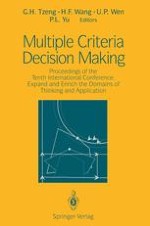It was a great honor and privilege to organize the Tenth International Conference on Multiple Criteria Decision Making at Taipei, Taiwan, July 19-24, 1992. Accompanying this unique honor and privilege there was a series of complex, challenging problems. Each of them involved multiple criteria, fuzziness, uncertainty, unknown yet dynamic changes. The problem sometimes cost us sleep because we wanted to do the very best job, but in reality it seemed to be impossible. The following are the main goals of the organization committee: (i) inviting all prominent and distinguished MCDM scholars around the world to participate in the conference and to present their up-to-date research results, (ii) providing financial aid and hospitality so that each invited speaker can have free room and board at a five star hotel, (iii) creating an environment so that all participants can freely exchange their ideas, and build friendships around the world. Due to the enthusiastic participation of the prominent scholars, the generous support of the Taiwan government, universities, the Industrial leaders and nonprofit foundations, and the active problem solving attitude and doing of the organizational committee and the Habitual Domain (HD) club, the conference was a great success.
